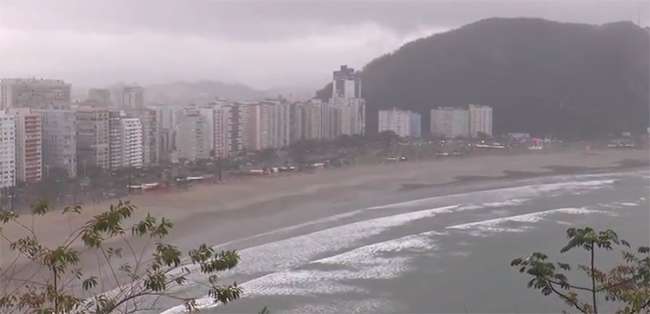Failing to adapt to climate change likely to cost at least five times more

Coastal cities deal with the constant fear that sea levels will continue to rise in coming years due to climate change. In the case of Santos, home of Latin American's biggest harbor, a study supported by the São Paulo Research Foundation (FAPESP) estimates that by 2100, the sea level might be 45 cm higher, bringing more frequent storm surges at 20 cm, surpassing current peak levels.
The study, titled Project Metropolis, defined the minimum costs for Santos to adapt for higher sea levels: approximately R$300 million worth of urban infrastructure renovations in the Ponta da Praia area, and also in the northwest region. On the other hand, failure to adapt to climate change would cost at least R$1.5 billion.
"However," says José Marengo, coordinator of Project Metropolis, "the cost could be underestimated at R$1.5 billion because the model only considers physical buildings and other structures, and the calculations are based on their imputed or taxable values. If we included losses in other areas, such as health and education, for example, the value would easily reach R$3 billion."
Luiz Eduardo Oliveira e Cruz de Aragão, an investigator at Brazil's National Space Research Institute (Inpe) and also a member of the project, sheds light on the broad impact of climate change on the health sector. Risk analysis and the investigation of adaptive strategies, according to Aragão, identified a connection between El Niño and the rising number of dengue cases in the summers of 2010 and 2015—in these years, the expenditure on patient hospitalizations and treatments in Santos rose by at least R$720,000.
"We estimated some of the impacts on health, but if all diseases linked to rising temperatures and flooding are factored in, we can see the real impact of this problem in the area of health," said the researcher.
Future scenario points to the increase of floods
Sea levels in Santos have risen at different rates since the 1940s. "Based on time series, we identified two possible scenarios for the city. One is more realistic, with sea levels rising by 0.36 cm per year. The other is the worst-case scenario, with sea levels rising by 0.45 cm per year. The conclusion was that sea levels could rise between 18 cm and 23 cm by 2050, and between 36 cm to 45 cm by 2100," said Celia Regina de Gouveia Souza, a researcher at the Geologic Institute (IG) of the Sao Paulo State a member of the project team.
The model also considers the occurrence of extreme events, such as meteorological tides and storm surges, which are increasingly frequent because of climate change and result in rapid rises in sea level.
According to Gouveia Souza, who maintains a database of the occurrences of extreme events from 1928 to 2016 in the Santos city area (the so-called Baixada Santista region), the frequency of storm surges has increased significantly, as has the number of consecutive years with storm surges since the late 1990s.
"The Santos tide gauge data tables show that the peak rise during one of these extreme events in the 2000s was 146 cm," she said. "According to our projections, it could reach 160 cm in 2050 and 166 cm in 2100. This means that the city will be even more vulnerable to coastal floods and erosion, which will migrate toward Bairro do Embaré (Canal 4 surroundings)."
Having produced the coastal flooding scenarios for 2050 and 2100 and calculated the potential damage to buildings, the researchers shared their findings with the population of Santos and the local government to discuss appropriate adaptive measures. "Options for adaptation were brought up at these town hall meetings," Marengo said. "One option is fortification using revetments, seawalls and structural enhancements. In other cases, it's possible to opt for beach replenishment. Another strategy we see as necessary for Santos is mangrove rehabilitation, which can be classified as an ecosystem-based adaptation."
"The measures chosen by the public were quite adequate. We hope the project will continue under the aegis of the local authorities with ongoing popular participation. If so, the worst-case scenario is much less likely to materialize," said Luci Hidalgo Nunes, a researcher at UNICAMP and a project team member.
The city of Santos was chosen by the Project Metropolis team not just for its economic importance, but also because its tidal, rainfall, temperature and storm surge data time series are the best among Brazil's coastal cities.
"Although scientists and decision makers must discuss adaptations, it has to be public policy. It must come from the government," Marengo said. "It's an action that cannot stop, and obviously there must be an investment. Santos has achieved a high level of awareness, with a broad dialogue involving the public, decision makers and academia. The construction projects must be implemented. The worst thing that could happen would be if it all stayed on the drawing-board."
More information: An integrated framework to analyze local decision-making and adaptive capacity to large-scale environmental change: community case studies in Brazil, the UK and the US. bv.fapesp.br/en/auxilios/81993 … -large-scale-enviro/
Provided by FAPESP

















